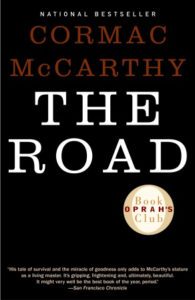
This semester, I decided to teach The Road by Cormac McCarthy. After I got my desk copy, I was sitting on BART, on my way home, and I started rereading the ending to try to figure out how McCarthy made it so moving when the pages building up to it are written in such a spare, Hemingway-esque, reportage style. And suddenly, there I was, surrounded by commuters, my tears, snot and sobs spurting out. Dammit, he did it to me again. The tiniest glimmer of hope he offers the reader (after chapters and chapters of desolation) is painfully beautiful.
The concept behind The Road is simple—McCarthy takes all of our collective Alas-Babylon/The-Day-After-nuclear-bomb-environmental-disaster-apocalyptic fears and elevates this theme into the realm of art. What would you do if IT happened? Would you have the (bad-ass) skills it would take to survive? How? He succeeds in shaping such desolate territory into literature because he knows that relationships drive any story. Instead of focusing on the how and why of the unnamed catastrophe that has reduced the earth to dead trees and ash, The Road centers on one father’s quest to protect his young son in this new and terrible world.
I first found The Road under the golden lighting of the Henry Miller library in Big Sur. As the rain came down, I sat in a chair and read. A little later, I looked up and realized I had sucked down the first fifty pages. (I was too broke to buy it, but luckily, my friend bought something, so I didn’t feel too bad.) I finished reading it when I was bedridden with the flu. It was the best time to take in such a book: feeling clogged, surrounded by wads of toilet paper, lying under sheets that smelled of my own sweat, half-wishing for death. As I read the last scene, of course, I cried, because it was so quietly emotional, and because I wasn’t ready for it to end.




